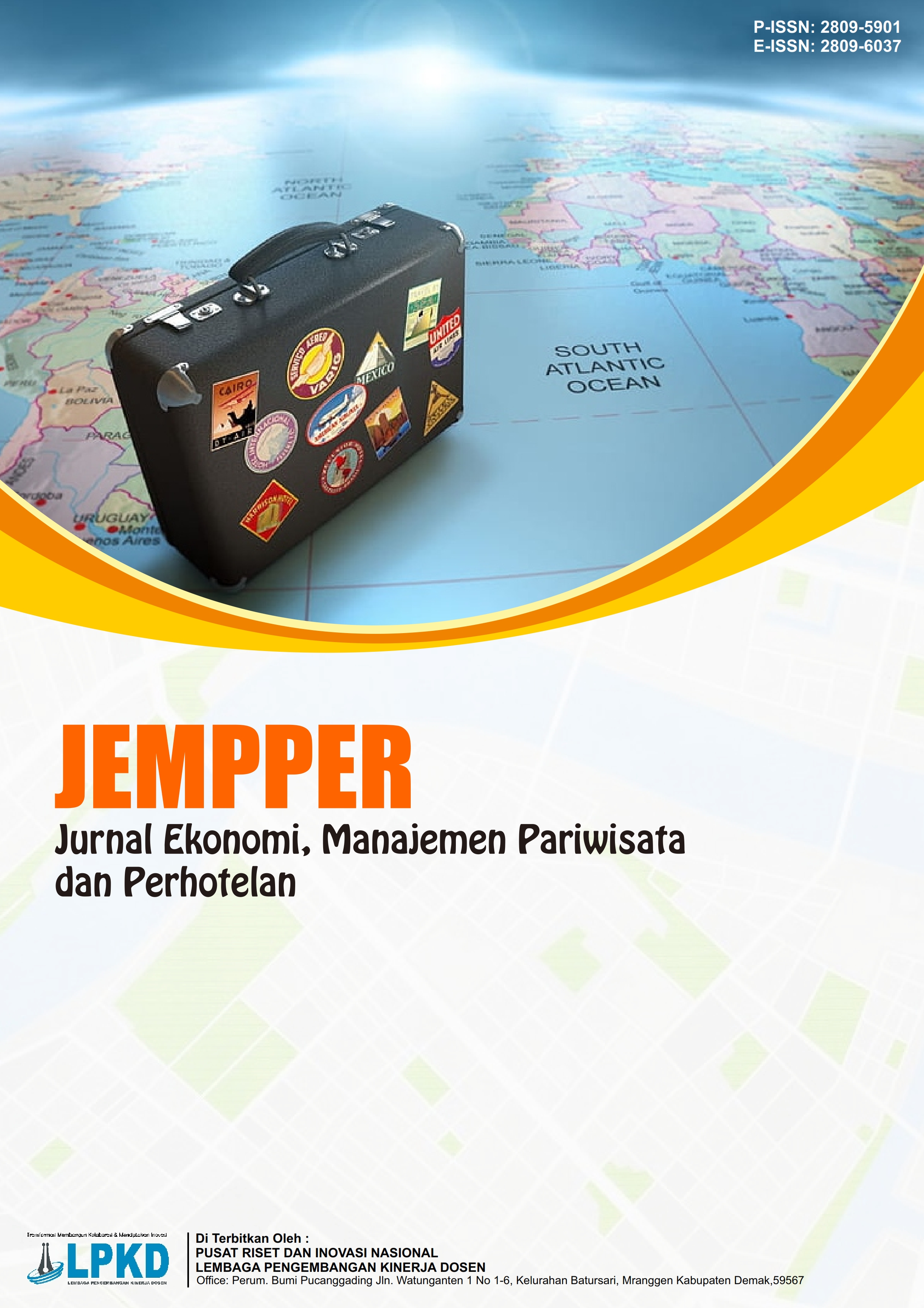Keberlanjutan Wisata Mangrove Silau Laut Dalam Perspektif Ekologi Dan Pariwisata
DOI:
https://doi.org/10.55606/jempper.v4i1.3903Abstract
Silau Laut Mangrove Tourism in Silo Baru Village, Asahan Regency has developed into a community-based ecotourism destination. This study aims to assess the balance between ecological conservation and tourism development at the site. Using qualitative methods, this study employs field observations, stakeholder interviews, and policy analysis. Findings show that although tourism boosts the local economy, significant challenges exist in preserving mangrove ecosystems, particularly from increased tourism activities and oil palm expansion. Strategic recommendations include strict regulations, community empowerment, environmental education, and eco-friendly infrastructure development. Integration of government programs like BRGM reinforces sustainability. The study contributes to developing a sustainable ecotourism management model integrating ecological, social, and economic perspectives.
References
[1] I. Effendi, D. Yoswaty, I. Harahap, J. Jupendri, and A. Andrizal, “Mangrove Conservation, Ecotourism, and Development Strategy in Bandar Bakau Dumai, Indonesia,” J. Environ. Manag. Tour., vol. 13, no. 5, pp. 1443–1452, 2022, doi: 10.14505/jemt.v13.5(61).19.
[2] E. Damastuti and R. de Groot, “Effectiveness of community-based mangrove management for sustainable resource use and liveli-hood support: A case study of four villages in Central Java, Indonesia,” J. Environ. Manage., vol. 203, pp. 510–521, 2017, doi: 10.1016/j.jenvman.2017.07.025.
[3] E. B. P. Bischoff, K. Aning, and A. Acharya, “20 % Off All Books & eBooks during April Savers , Limited Africa in Global Inter-national Relations Emerging approaches to theory and,” pp. 1–4.
[4] F. Nouban and M. Abazid, “Plastic degrading fungi Trichoderma viride and Aspergillus nomius isolated fromNouban, F. and Ab-azid, M. (2017) ‘Plastic degrading fungi Trichoderma viride and Aspergillus nomius isolated from local landfill soil in Medan’, Iopscience.Iop.Org, 8(February ,” Iopscience.Iop.Org, vol. 8, no. February 2018, pp. 68–74, 2017, doi: 10.1088/1755-1315.
[5] D. Mashur, M. Ikhsan, Ismandianto, and F. Yuliani, “Prospective analysis of sustainable mangrove ecotourism development policy,” E3S Web Conf., vol. 506, 2024, doi: 10.1051/e3sconf/202450606002.
[6] R. N. Afifah et al., “Ecotourism development as a community-based conservation effort in Ayah Mangrove Forest, Kebumen, Central Java, Indonesia,” Asian J. For., vol. 7, no. 1, pp. 37–44, 2023, doi: 10.13057/asianjfor/r070105.
[7] E. S. Mandiangan, H. Rinwati, A. B. Sambah, and Supriatna, “Mangrove Tourism Suitability Index and Ecotourism Sustainability in the Waters of Talengen Bay, North Sulawesi Province, Indonesia,” Egypt. J. Aquat. Biol. Fish., vol. 28, no. 5, pp. 929–943, 2024, doi: 10.21608/ejabf.2024.382105.
[8] L. Hakim, P. Deoranto, T. Ayu, E. Pangestuti, and D. C. Natalia, “Mangrove Biodiversity and Conservations: Foundation Toward Ecotourism Implementation in Bintan Island, Indonesia,” Int. J. Conserv. Sci., vol. 14, no. 3, pp. 1139–1150, 2023, doi: 10.36868/IJCS.2023.03.23.
[9] D. R. Riana et al., “The Functions of Myth in Mangrove Ecotourism Development in Ibu Kota Nusantara, Indonesia,” J. Mar. Isl. Cult., vol. 13, no. 1, pp. 92–110, 2024, doi: 10.21463/jmic.2024.13.1.06...
[10] R. Novianti, A. Y. Afandi, B. I. Tampubolon, A. Rahmadya, and F. Sulawesty, “Mangrove Resource and Ecotourism Development in Karangsong, Indramayu Regency, West Java, Indonesia,” IOP Conf. Ser. Earth Environ. Sci., vol. 1062, no. 1, 2022, doi: 10.1088/1755-1315/1062/1/012039.
[11] I. Purnama, “Recreational Value of Mangrove Ecotourism: A Case Study in Jerowaru East Lombok, Indonesia,” Int. J. Multidiscip. Res. Anal., vol. 6, no. 9, pp. 4299–4304, 2023, doi: 10.47191/ijmra/v6-i9-45.
[12] A. Blanton et al., “Ecotourism and mangrove conservation in Southeast Asia: Current trends and perspectives,” J. Environ. Manage., vol. 365, 2024, doi: 10.1016/j.jenvman.2024.121529.
[13] A. Nurhayati, N. Akbarsyah, W. Pamungkas, T. Herawati, and A. Yustiati, “Strengthening Local Community in Mangrove Ecotourism at Pangandaran, West Java Province, Indonesia,” Asian J. Fish. Aquat. Res., vol. 21, no. 3, pp. 44–52, 2023, doi: 10.9734/ajfar/2023/v21i3543.
[14] D. J. Prihadi, G. Zhang, G. M. Lahbar, and B. Pasaribu, “Integration of Community-Based Tourism (CBT) Index and Biophysical Assessment for Sustainable Ecotourism Mangrove: A Case Study of Karangsong, Indonesia,” Sustainability, vol. 16, no. 7, 2024, doi: 10.3390/su16072806.
[15] R. Hakim Manan, “The Concept of Mangrove ECO Tourism Master Plan in Belitung District Indonesia,” Int. J. Eng. Res., vol. 9, no. 2, pp. 323–330, 2020, doi: 10.17577/ijertv9is020169.
[16] FAO, The World's Mangroves 2000–2020, Food and Agriculture Organization of the United Nations, Rome, 2020.
[17] Kementerian Lingkungan Hidup dan Kehutanan Republik Indonesia, Laporan Status Mangrove Nasional, KLHK, Jakarta, 2023.







